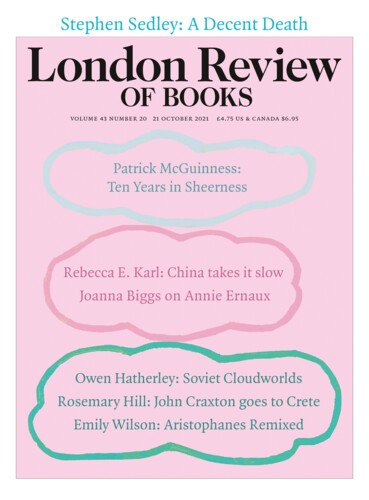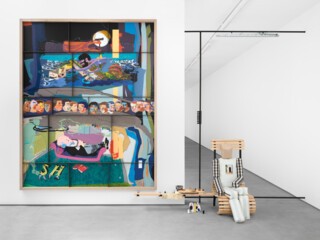‘There is something interesting to be said for everything around us,’ Charles Schulz’s Linus says in a Peanuts-derived commercial for Weber’s bread, first broadcast in the late 1960s. But there’s interesting and there’s interesting: sometimes you just get lost. The first work I saw by the British artist Helen Marten, about eight years ago, was a sculpture resembling a makeshift desk or lectern, on and around which were strewn various baked goods, a sheet of beaten copper and a pile of pizzeria flyers showing Gerhard Richter’s 1988 painting Betty. The piece was titled Peanuts, and it included, drawn in black metal, the zigzag pattern from Charlie Brown’s sweater – a device I failed to recognise at first. With Marten, it’s easy to be captivated by oddities and miss the most obvious references in her bristling, meticulous work. In the case of Peanuts, a putative connection between sculpture and cartoon animation. (‘The line of the cartoon,’ Marten has said, ‘activates substance beyond conventionally plausible limits.’) If anything, her recent work is more teeming and devious – and no less seductive.
In 2016 Marten won both the Turner Prize and the first Hepworth Prize for Sculpture. Last year she published The Boiled in Between: a novel of sorts that translates into prose some of the jam-packed erudition of her art and its ickier explorations of bodies, text, images and mere (it’s never mere) stuff. Visiting Sparrows on the Stone, Marten’s current exhibition at Sadie Coles (until 30 October), first impressions are of a marshalled profusion of monstrous forms, deluxe materials, found imagery, everyday objects in states of decay, gobbets of text half recognised from fiction or poetry, more cartoon scenes and characters of uncertain provenance. The gallery’s press release mentions sixteen works on paper, twelve paintings and two ‘floor-based sculptures’, though in fact there is something sculptural happening everywhere you look. An armature of reinforcing rebar supports the paintings and their attendant objects, portioning up the space at ankle height – a sparse, light underpinning for work that is dense with detail and significance.
The layout of the exhibition is meant to sketch a human body lying with its head at the entrance and its legs at the far end of the gallery. More exactly, or rather less exactly, it’s a stick figure, the body reduced to head, trunk and limbs. Versions of this silhouette are dispersed throughout the show, like little semaphore signallers or the cipher made of stick figures in Arthur Conan Doyle’s ‘The Adventure of the Dancing Men’. (Further messages: the ‘SOS’ of the show’s title; some dots and dashes of Morse code in the paintings.) A painting titled Two Regimes of Madness (Professor Lichen) dominates the section of the room that represents the head. In the bottom half, a cartoonish Freud lies on his couch with a circle of stars above him, a book face down on the floor, and the letters ‘S’ and ‘H’ trotting past him on tiptoe. In the top half – all of this in garish nylon paint-on faux-leather fabric – a dishevelled and grinning man on a raft reaches eagerly towards a floating wooden box from which a loaf of bread protrudes. Next to the picture sits a cushiony dummy, faceless, made of gingham and mattress ticking (on the wooden slats of the dummy’s chair is an envelope from the ‘American Sponge & Chamois Co.’). Painted or upholstered, these figures preface all manner of bodies and personae in the exhibition: children, clowns, police officers and mischievous animals.
Look closer, and there are delicately painted faces everywhere. In the centre of Dead Souls (boots) – is that a tiny glum Nosferatu? And nearby a red-nosed approximation of W.C. Fields, or Mr Magoo? A set of footprints dances across the surface, but the prints look curiously like Al Capp’s globular, edible Shmoo, or its shapeshifting cartoon descendants, the Barbapapa family. The comic and cartoon elements aren’t just static motifs, but reminders of the larger slapstick logic at work across Marten’s paintings, sculptures, drawings and writings. Slapstick as in one damn thing after another, enacted swiftly or (more likely) with infinite slowness for the pleasure of seeing a wholly predictable chain of causality or reasoning play itself out to the fullest extent. With Marten’s sculptures, there is always one more iteration, another obscure attachment, a formal or conceptual hinge about to hit something or someone on the head. In A tantrum carved from stone, which seems to make up the guts and genitals of the notional body, a kind of rubber-slung deckchair structure supports a tower of small cylindrical dwellings. Alimentary pipework in wood and resin emerges from the tower and drapes itself over a patchwork metal funnel, to end at length in a brassy socket and pink earbud-shaped terminus.
Some of these artefacts and materials look like themselves, others are smoothly deceptive. Is that a real coil of orange peel, or a simulacrum Marten has had specially made? Wax or plastic? Ceramic or steel? Two tiny wooden platforms or tables, covered in chamois and littered with foil tops from individual butter portions, are labelled ‘Real Fiction’ and ‘Real Facts’. At times, it helps to consult a list of materials that have gone into a particular sculpture, but you will just as likely be confused as to what is what, and conclude that these lists, with their implied narrative of implausible material conjunctions, are also part of the work. A tantrum carved from stone contains ‘model board, mixed hardwoods, chipboard, aluminium, glazed ceramic, steel, silkscreened Formica, cast PU rubber, milled timber, cast Jesmonite, cast resin, fabric, curved needle, dry transfers, coloured pencils, lacquered cardboard, milk bottle tops, ring pulls, ceramic tile, plastic bowl, plaster, string, paper, hammered lead, embroidered fabric, yoghurt pot, marbles’.
Everything in Marten’s work begins, she says, with writing. The lists of materials, paratactic but mysteriously ordered, are just the most deadpan instance of her oddly grammatical imagination. What are her sculptural chains of obscure relation if not actually sentences of a kind, structured and polished but somehow also botched and obscure? I don’t think I have ever come across an artist whose prose so matches the visual and material practice. Here, from The Boiled in Between, is her description of a garden sprinkler: ‘Strung with tensile integrity cells amongst a web of slender tendons there is a complex network of pipes.’ One of her protagonists, Ethan, wonders: ‘Well what is a body anyway, when framed in words? A dough trough? A collapsing figure for poking and kneading? For baking, for burning, for pulling apart like a hot-pocketed roll?’ There are numerous small literary quotations in Sparrows on the Stone – passages from Auden, Anne Carson, William Gass – but none of them are quite so peculiar as Marten’s own style, whether in prose or in polished Jesmonite.
In an essay on the word ‘and’ in his Habitations of the Word, Gass writes: ‘To the logician, who is at least patient and untiring, if not soothing and submissive, a connective like “and” or its sometimes substitute, the comma, asserts the joint dependency of every element in the pursuit of truth.’ In one of Marten’s paintings, there is a light rain of commas, or perhaps they are spilled quotation marks. Connectives, substitutes, dependencies: these in the end seem like the essential material or medium out of which her art is made; everything happens in between the exquisite or mundane substances, between the carefully mangled phrases. She is not above some seemingly direct visual invocation of precursors or primal scenes. Among the small works on paper in an adjacent room, there are two drawings in coloured pencil showing a topless man having his chest and back decorated by another man. They are based on photographs taken in 1969 at Yaddo; the bare torso belongs to Gass, and the painter is Philip Guston.
Send Letters To:
The Editor
London Review of Books,
28 Little Russell Street
London, WC1A 2HN
letters@lrb.co.uk
Please include name, address, and a telephone number.


